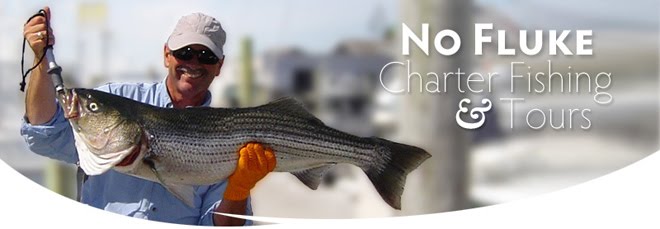Captain Dave caught two tautog this Sunday at Coddington Cove in Middletown, RI. This 22’ fish took a green crab in about 15 feet of water right on top of the jetty.
This was a busy week for saltwater fishing. Rhode Island’s fishing license law took effect Friday, April 16 along with new 2010 fishing regulations. A new volunteer electronic recreational saltwater fishing logbook was announced by the Department of Environmental Management (DEM) and Thursday, April 15 was the start of the tautog season.
State saltwater fishing license
The license is available online at http://www.saltwater.ri.gov/ and will be sold at bait shops starting June 1. The cost is $7 per year for RI residents and $10 per year for non-residents. There is a temporary 7-day license available for $5. The license is free for anglers over 65 years of age and for active military personnel stationed in Rhode Island.
No license is required for anglers under 16 years of age, for anglers fishing on licensed party and charter boats, for anglers who are on leave from active military duty, and for anglers who are blind or permanently disabled.
The RI license enables the holder to fish in RI and federal waters as well as in all state marine waters throughout southern New England and other states that have reciprocal agreements.
The license program is designed to improve the quality of marine recreation fishing data which will in turn help insure that recreational fishing regulations are fair and based on sound science. Data from RI and other states will be put into a national data base allowing the new Marine Recreational Information Program to survey current fishermen.
Here is the part I like… all of Rhode Island’s saltwater license fees will be put in a restricted account and can only be used for marine recreational fishing such as program administration, to improve the management of Rhode Island’s marine recreational fisheries or to enhance recreational fishing access.. This law is good. It was written by DEM in conjunction with the Rhode Island Saltwater Anglers Association.
2010 saltwater fishing regulations
New 2010 saltwater fishing regulations have been announced by DEM The regulations govern fishing for summer flounder, black sea bass, scup, and weakfish (there are no changes for striped bass or tautog); commercial regulations were also announced. Visit http://www.dem.ri.gov/ for details, here are some highlights.
Summer flounder: The season opens on May 1 and runs through December 31. The minimum size is 19.5”, possession limit remains at 6 fish/person/day.
Black sea bass: Season runs from May 22 through September 12. The minimum size is 12.5”, possession limit remains at 25 fish/person/day.
Scup: The fishery has two modes. For the general mode (everyone except those fishing on party and charter boats), the season runs from May 24 to September 26. The minimum size remains at 10.5” with a 10 fish/person/day catch limit. For the party and charter boat mode the minimum size is 11”; the season runs from June 8 to September 6 with a 10 fish/person/day. The possession limit then increases to 40 fish/person/day from September 7 through October 11.
Weakfish: The fishery remains open year-round, and the minimum size remains at 16”. However, the daily possession limit is t 1 fish/person/day).
Striped bass: The regulations for 2010 are the same as last year: a year-round season, a 2 fish/person/day possession limit, and a 28” minimum size.
Tautog: The regulations are the same as last year: 16” minimum size, the season opens on April 15 at a 3 fish/person/day possession limit, then closes for the month of June, and then reopens from July 1 through October 16 at 3 fish/person/day, increasing to 8 fish/person/day from October 17 through December 15.
New volunteer electronic recreational saltwater fishing logbook
DEM’s Marine Fisheries Program and the Atlantic Coastal Cooperative Statistics Program has developed a volunteer electronic recreational saltwater fishing logbook. Information is presented in graphic and tabular format. Anglers will be able to see their catch history in real time. For more information and to sign up go to http://www.saltwater.ri.gov/ .
Where’s the bite
Tautog season opened April 15. Several fish caught at Spindle Rock and Ohio Ledge said Ken Ferrara of Ray’s Bait and Tackle in Warwick. I stopped by to see Ken for the first time since he was out ill at the end of last season and he is doing well. Ken is an outstanding angler and bait and tackle shop owner. He has helped thousands of anglers with good advice including me. Nice to have you back Ken. I caught two tautog Sunday at Coddington Cove, Middletown (one was 22”). Dave Henault of Ocean State Tackle, Providence, reports a slow tautog bite in the Bay but off-shore fishing is good with thirty fish being taken off Westport. Dave said that turbulent water with a lot of particles is not good for tautog fishing. It keeps the fish off shore in deeper water.
Striped bass season is underway. Steve McKenna of Cranston and an employee of Quaker Lane Outfitters reports an outstanding school bass bite at the West Wall in Narragansett. Most were caught in the late afternoon and just before dark. The fish were primarily caught on three and four inch pearl Cocohoe minnows and the new Bomber mud minnow in the four inch model. Both soft plastics were fitted on ½ lead head jigs for casting weight. Steve said, “There is a lot of bait in the area. More bait than I have ever seen in many a year.” This is encouraging, especially since Steve has been one of Rhode Island’s best shore striper fishermen for over 30 years. Craig Castro of Erickson’s bait & Tackle, Warwick, reports customers catching school bass off Chepiwanoxet Point, Warwick using soft plastic baits.
Freshwater bite remains good. Craig Castro of Erickson’s Bait and Tackle reports a good trout bite at Carbuncle Pond and all ponds/lakes stocked by DEM… Lincoln Woods, Silver Spring Lake and others noted on DEM’s web site (http://www.dem.ri.gov/ ).


